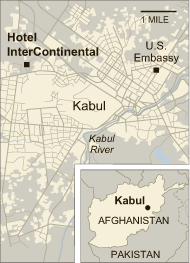 KABUL, Afghanistan — Several heavily armed attackers stormed one of the capital’s fortified premier hotels on Tuesday night, and sporadic shooting and at least two loud explosions were heard as Afghan security forces battled insurgents for hours afterward.
KABUL, Afghanistan — Several heavily armed attackers stormed one of the capital’s fortified premier hotels on Tuesday night, and sporadic shooting and at least two loud explosions were heard as Afghan security forces battled insurgents for hours afterward.
Coming within a week of President Obama’s announcement of troop withdrawals from Afghanistan, the attack underscored the still precarious nature of security, even in the capital, as the transfer of responsibility to Afghan forces is about to begin in several areas of the country, including Kabul.
In the early hours of Wednesday morning, three attackers on the roof of the Intercontinental Hotel were killed by NATO helicopters, a NATO spokesman said.
There were six insurgents in all, said a spokesman for the Interior Ministry, The Associated Press reported. In addition to the three killed on the roof, two others were killed by hotel guards at the beginning of the assault and another was killed either in the attack by the NATO helicopters or by Afghan security forces, The A.P. reported.

At least seven other people were killed in the attack and eight were wounded, said the Kabul deputy police chief, Daoud Amin, according to The A.P. The assault ended about 3 a.m.
The heavily guarded Intercontinental Hotel, which sits on a hill on the western side of Kabul, has police guards at its base and intelligence officers stationed at the top of the hill and near the entrance. It was not clear how so many attackers could have breached the building’s defenses.
Attacks in Kabul have been relatively rare, although in May there was an attack on a similarly soft target: a bomber detonated his explosives inside a military hospital, killing six people.
In announcing the troop withdrawal, Mr. Obama said he could reduce the number of American forces because the influx of about 30,000 troops that he ordered more than a year ago had succeeded in pushing back the Taliban. Although the insurgents have been set back, particularly in their strongholds in the south, they have proved themselves still capable of carrying out assassinations and suicide bombings even in urban centers.
Also on Tuesday, the White House’s nominee to become the next American commander in Afghanistan faced tough questioning from a Senate panel about President Obama’s plan to pull troops from the country.
The nominee, Lt. Gen. John Allen, said that “surge” of more than 30,000 American troops had halted the Taliban’s momentum in southern Afghanistan, but he added that the fighting remained intense as insurgents were trying to regain lost territory.
Testifying before the Senate Armed Services Committee, General Allen echoed comments by other top commanders in recent days, saying that military leaders advised a more conservative drawdown of troops over the next year than the plan that Mr. Obama announced last week.
In the Kabul attack, a NATO spokesman said that the international forces tracked the situation through the night but left the fighting to the Afghans until early Wednesday when the International Security Assistance Force was called in.
“Two ISAF helicopters circled the roof of the hotel and then identified three individuals believed to be insurgents on the roof, and the helicopters engaged the individuals with small arms,” said Maj. Tim James, a NATO spokesman. “They were all wearing suicide vests and were armed and there were at least two explosions which we believe were the suicide vests detonating. Then Afghan National Security Forces who were in the hotel and were clearing the hotel worked their way onto the roof and were securing the roof.”
Samoonyar Mohammad Zaman, a security officer for the Interior Ministry, told The Associated Press that the insurgents were armed with machine guns, antiaircraft weapons and rocket-propelled grenades.
Mr. Zaman said there were 60 to 70 guests at the hotel. One guest, Jawid, told The A.P. that he had jumped out of a first-floor window to flee the shooting. “I was running with my family,” he said. “There was shooting. The restaurant was full with guests.”
The Taliban took responsibility for the attack, saying they intended to kill foreigners and Afghans, said Zabiullah Mujahid, the Taliban spokesman for northern and eastern Afghanistan.
“Our muj entered the hotel,” he said, referring to the Taliban mujahedeen fighters, “and they’ve gone through several stories of the building and they are breaking into each room and they are targeting the 300 Afghans and foreigners who are staying.” His claims could not be immediately confirmed.
At least six stories high, the Intercontinental is one of the largest hotels in the city and is frequented by foreigners as well as Afghan officials who stay there while they are in Kabul on business. It is also often used for conferences and political gatherings.
A major conference starts Wednesday in Kabul on the transition of NATO military and civilian control to the Afghan government, but none of the official meetings were scheduled to take place at the hotel.
The attack was reminiscent of several other recent ones in which multiple insurgents have converged on a public place. More than 27 attackers converged on downtown Kandahar in May, killing four people, and in February seven gunmen wearing suicide vests entered the Kabul Bank branch in the eastern city of Jalalabad and killed 18 people.
Similarly, in October 2009 several suicide bombers and gunmen stormed a United Nations guest house in Kabul. By the end of the siege, at least eight people were dead along with three attackers.
And in January 2008 a suicide bombing at the Serena Hotel in Kabul killed at least six people.
Copyright 2011 by The New York Times


 ) in the application bar at the top of the workspace.
) in the application bar at the top of the workspace.